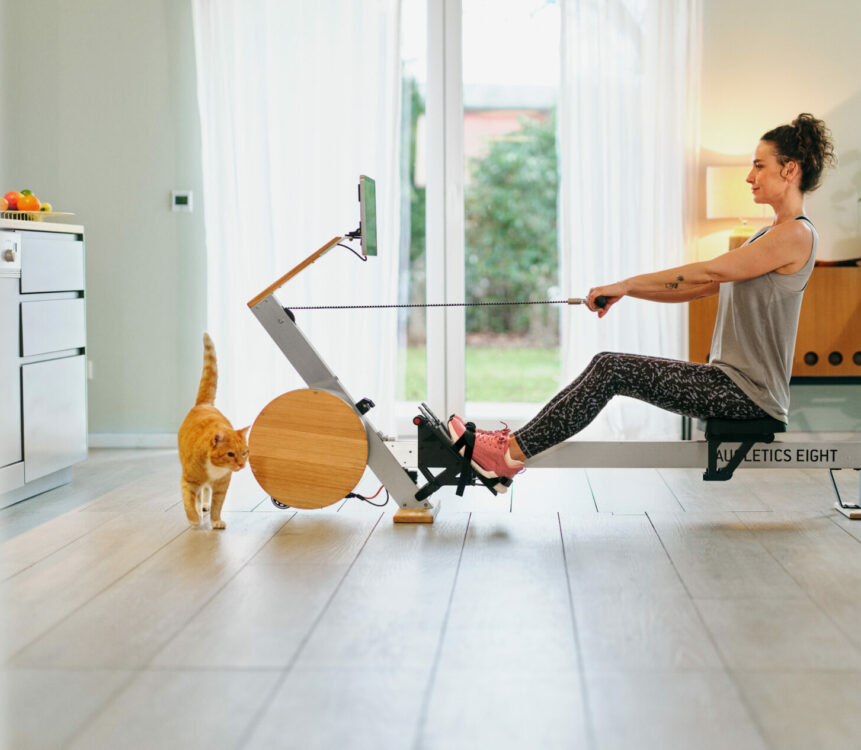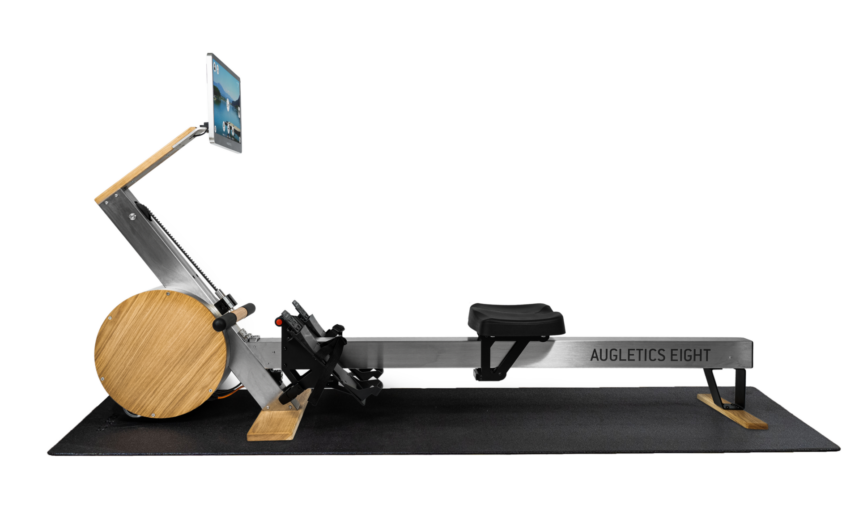Welches Rudergerät passt
zu mir? Der vergleich
You don't know much about rowing training and which is the best rowing machine for you personally? Here we have compiled all the important points for you so that you have a complete overview. We then compare six different rowing machines in points such as: braking system, geometry, value for money, design and how the rowing feels.
Water-braked system
First, let's take a look at the WaterRower as an example. This consists of a water tank containing a flywheel, which is connected to a handle by a chain or rope. When you want to row on the device, you pull the handle to spin the flywheel, which then moves the water through the tank and creates resistance. The faster you pull the handle, the more resistance will be affecting the row. The WaterRower is like that
Magnetic brake system
A magnetic brake rower, such as the Matrix rower, uses a magnetic braking system to create resistance as you row. A magnet is positioned near a metal disk that is propelled by rowing. By changing the strength of the magnetic field, the distance between the magnet and the disk is varied, which regulates the resistance. The magnetic braking system offers some advantages, such as quiet operation and precise resistance control. In addition, it does not require maintenance or refilling of water, as is the case with water-braked rowing machines. However, the rowing feel of magnetically braked rowing machines can be perceived as less realistic compared to water-braked rowing machines. Here we also have a rather rudimentary screen, which is small. This only offers you the stroke frequency per minute, the wattage, the time and the total meters. The entire rowing motion doesn't feel very realistic as the flywheel at the front always has a stiff resistance in the reversing motion. The advantage here is that the rowing machine is very quiet. In terms of design, we're more in the gym here. It's not really a fitness device that you put in the living room, for example. The device is very large, does not fold and is difficult to place anywhere. Here we are in the price range from €500 to €3000. It mostly depends on how the construction is. With a small design, the device is significantly cheaper than with a robust design.

Air-brake System
Air-braked rowing machines, such as the Concept2 rowing machine, use an air resistance system to create resistance when rowing. A rotating metal disc inside the housing provides resistance, while rowing forces air through the machine, increasing resistance. The harder you row, the higher the resistance. An advantage of air brake rowers is that they offer a more realistic rowing feel than magnetic brake rowers. In addition, compared to water-braked rowing machines, they are often less expensive and do not require regular maintenance or topping up with water. However, they can be noisy due to the air ingress and egress when rowing. In addition, it can be difficult to precisely control the resistance as it depends on the rowing speed and cannot be adjusted manually. In contrast to the other displays, we have a much larger range of functions here. So we not only have the wattage, the time driven in 500 meters or the total driving time, but also a graphic power curve and the possibility to connect Bluetooth. The geometry and the resistance, as well as the entire rowing movement comes very close to rowing on the water. The device can be disassembled into two parts relatively easily. When assembling it is a bit more complicated from time to time, but not an obstacle. Of course you also need the space for two individual parts, but it is still better than a huge rowing machine standing in the middle of the room. Air-braked rowing machines are priced in a range from €800 to €1500 (Depending on the manufacturer and design).
Electrically controlled magnetic brake
A rowing machine with an Electronic Controlled Magnetic Brake uses a magnetic resistance system to create resistance. Unlike an air or water resistance rowing machine, where resistance is created by the resistance of the air or water, the magnetic resistance system creates resistance by attracting magnets to a rotating flywheel. The resistance can be controlled with an electronic controller, usually built into the rowing machine console. With this control, the user can increase or decrease the resistance during the workout, depending on how intense you want the workout to be.
Diese Geräte haben den Vorteil, dass sie genauso leise sind wie die Magnetbremse, jedoch durch die elektronische Steuerung ein sehr natürliches Rudergefühl bekommen. Exemplarisch schauen wir uns hier das AUGLETICS an. Das große Display bietet hier eine Vielfalt an Funktionen. So sehen wir auch hier unsere Ruderparameter, wie bei den zuvor genannten Geräten, können aber auch mit anderen online zusammen rudern und uns dabei durch beispielsweise Paris oder Monaco bewegen. Dabei gibt es wöchentlich, wechselnden, kostenlose Strecken. Des Weiteren haben wir hier den Zugriff auf eine Trainerfunktion, die uns darauf hinweist, welche Varianten des Ruderschlages gut oder ausbaufähig ist. Hier kommt das Gerät dem Rudergefühl sehr nah. Das Gerät lässt sich sehr gut zusammenklappen und verstauen und ist somit perfekt für den Heimgebrauch. Der einzige Nachteil ist, dass das Gerät preislich eher teurer ist. Dafür steckt das AUGLETICS voll von Funktionen, die einen motivieren, das Gerät auch wirklich zu benutzen. Diese sind alle im Preis inbegriffen und es gibt im Vergleich zum Wettbewerb keine zusätzlichen, monatlichen Kosten. These functions require not only software but also solid hardware, which is easy to use but complicated to engineer. Nevertheless, no compromises were made in terms of quality. You have to reckon with costs of 2600 and 3000 €. If you are unsure whether this might be an option for you, take a look at what customers think of AUGLETICS.

Hydraulic braking system
The hydraulic rowing machine is a not very common braking system. It consists of two handles attached to rods connected to a hydraulic system. When rowing, you move the handles backwards, pulling the bars with you. This creates hydraulic pressure in the device's cylinders, which works against resistance. The harder you pull, the higher the hydraulic pressure and the harder the rowing becomes. In addition, it only offers a few setting options and has a small range of motion. The screen (if any) is usually very small and offers few functions. Although the device is compact, small and space-saving, the rowing movement has very little to do with natural rowing. These devices are usually very cheap, so you can't really expect much.
Dynamic braking system
The dynamic rowing machine is more for professionals. Here we took a closer look at the RP3 MODEL S as an example. The RP3 Model S uses a patented spring and pulley system to create the resistance that gives the rower the feeling of rowing on water. The device differs from all the devices mentioned so far. Here the rolling seat is also mobile, but you only sit in one place if possible. In contrast to all other devices, the front part, i.e. to which the display is also attached, can be moved. Pull this front part towards you. The flywheel and spring and pulley system are arranged to create resistance that is similar to resistance when rowing on water. The spring and roller system consists of a spring attached to the base of the device on one side and a roller attached to the other side of the device. When you pull the handle back, the spring pulls the reel forward, creating the resistance. The harder you pull, the more resistance is created. The flywheel ensures smooth movement and stores the energy generated when rowing. This makes the RP3 Model S particularly efficient and enables gentle, natural rowing. The digital console records data such as stroke count, power, speed, distance and calorie consumption during training, enabling a personalized and optimized training experience. The rowing feel is very similar to rowing on water. The design here is more in a weight room or gym than in your own home. A Bluetooth interface is available here. Nevertheless, the device is more specialized for people who can really row or are involved in competitive sports. A big disadvantage is the loud sound, which is not very beneficial for home use. Due to the field of application of the dynamic rowing machine and the overall length, it is not intended that it should be stowed away to save space. It should stand in one place and be used there for a long time. Depending on the model, this type of rowing machine is in the price range of €500 to €3000.

Ultimately, you have to make it clear to yourself what is important to you personally and what you expect from your rowing machine. Basically, you can row on any device. The question here is rather what the long-term motivation looks like. Long-term motivation is much higher, especially if you have many functions such as trainers, card rowing and you can watch your favorite series at the same time. It is important that you test the devices intensively beforehand or get customer opinions to find out what suits you. Of course, a cheap rowing machine is much more attractive, but deal with it sufficiently and check whether your device also represents the functions and requirements you want. The same applies here: quality has its price. Find out which device convinces you the most. After all, it should be a good investment and you certainly want to use it in the long term and with motivation, right? Only then should you check whether the price-performance ratio is right for you or whether you need to look for a cheaper alternative.
Not enough? Find out more about rowing. We've written several helpful articles for you to get the full overview. You will find this here.